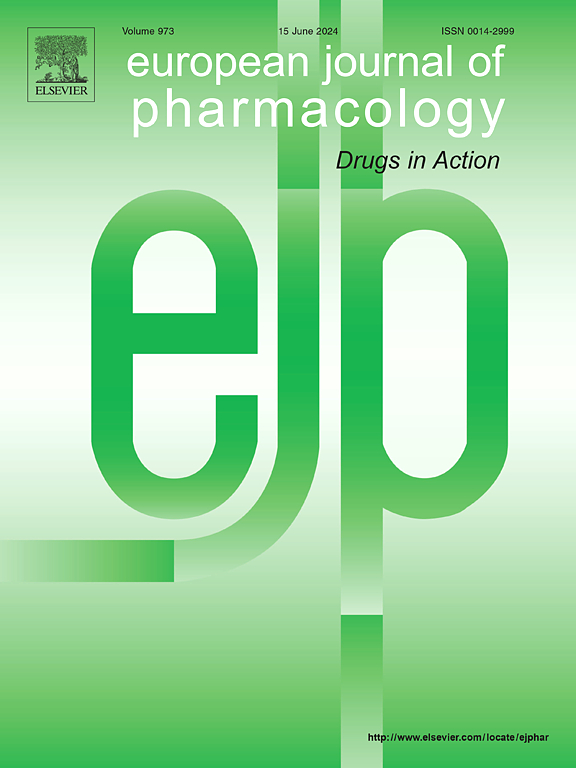Escin可通过BDNF/TrkB/CREB和TLR4/MyD88/NF-κB信号通路改善CUMS诱导的大鼠抑郁样行为。
IF 4.2
3区 医学
Q1 PHARMACOLOGY & PHARMACY
引用次数: 0
摘要
重度抑郁症(MDD)是一种常见的精神疾病,与脑部炎症和神经元损伤有关。从 Aesculus chinensis Bunge 果实中提取的 escin 具有抗炎和保护神经的作用。然而,它作为 MDD 治疗药物的潜力尚不明确。本研究通过体内实验研究了埃斯京的抗抑郁特性。研究采用了慢性不可预知轻度应激(CUMS)模型来分析埃斯京的潜在抗抑郁作用及其内在机制。将 Wistar 大鼠连续暴露于 CUMS 35 天,以诱发 MDD。然后每天给大鼠服用埃辛(1、3 和 10 毫克/千克)或氟西汀(2 毫克/千克)。值得注意的是,通过一系列行为评估,埃斯京明显减轻了CUMS诱导的抑郁行为。此外,服用埃斯京能降低海马中 TNF-α、IL-1β 和 IL-6 的水平。通过酶联免疫吸附试验(ELISA)测定,它还降低了CUMS大鼠血清肾上腺皮质激素(ACTH)和皮质酮(CORT)的水平,同时提高了5-羟色胺和脑源性神经营养因子(BDNF)的水平。通过 Nissl 染色确定了海马区的病理变化,并用 Western 印迹法量化了 BDNF、TrkB、CREB、TLR4、MyD88 和 NF-κB 的蛋白水平。埃辛减轻了 CUMS 大鼠的神经元损伤,提高了 TrkB、BDNF 和 CREB 的水平,降低了 TLR4、MyD88 和 NF-κB 蛋白水平。这项研究的数据表明,埃斯京有可能减轻 CUMS 诱发的抑郁症状。这种作用可能是通过调节两种信号通路(BDNF/TrkB/CREB 和 TLR4/MyD88/NF-κB)来实现的。本文章由计算机程序翻译,如有差异,请以英文原文为准。
Escin ameliorates CUMS-induced depressive-like behavior via BDNF/TrkB/CREB and TLR4/MyD88/NF-κB signaling pathways in rats
Major depressive disorder (MDD) is a prevalent psychiatric disorder associated with brain inflammation and neuronal damage. Derived from the Aesculus chinensis Bunge fruit, escin has shown anti-inflammatory and neuroprotective effects. However, its potential as a treatment for MDD is unclear. This study investigates the antidepressant properties of escin using in vivo experimentation. The chronic unpredictable mild stress (CUMS) model was used to analyze the potential antidepressant effects and underlying mechanisms of escin. Wistar rats were exposed to CUMS for 35 consecutive days to induce MDD. The rats were then given either escin (1, 3, and 10 mg/kg) or fluoxetine (2 mg/kg) on a daily basis. Notably, escin significantly alleviated the depressive behaviors induced by CUMS, as evaluated through a series of behavioral assessments. Moreover, escin administration reduced TNF-α, IL-1β, and IL-6 levels in the hippocampus. It also decreased serum adrenal cortical hormone (ACTH) and corticosterone (CORT) levels while increasing 5-HT and Brain-derived neurotrophic factor (BDNF) levels in the CUMS rats, as measured by the enzyme-linked immunosorbent assay (ELISA). Pathological changes in the hippocampal regions were identified through Nissl staining, and Western blotting was used to quantify the protein levels of BDNF, TrkB, CREB, TLR4, MyD88, and NF-κB. Escin mitigated neuronal injury, elevated TrkB, BDNF, and CREB, and reduced TLR4, MyD88, and NF-κB protein levels in CUMS rats. The data from this study suggest that escin holds the potential for alleviating depression-like symptoms induced by CUMS. This effect may be mediated through the modulation of two signaling pathways, BDNF/TrkB/CREB and TLR4/MyD88/NF-κB.
求助全文
通过发布文献求助,成功后即可免费获取论文全文。
去求助
来源期刊
CiteScore
9.00
自引率
0.00%
发文量
572
审稿时长
34 days
期刊介绍:
The European Journal of Pharmacology publishes research papers covering all aspects of experimental pharmacology with focus on the mechanism of action of structurally identified compounds affecting biological systems.
The scope includes:
Behavioural pharmacology
Neuropharmacology and analgesia
Cardiovascular pharmacology
Pulmonary, gastrointestinal and urogenital pharmacology
Endocrine pharmacology
Immunopharmacology and inflammation
Molecular and cellular pharmacology
Regenerative pharmacology
Biologicals and biotherapeutics
Translational pharmacology
Nutriceutical pharmacology.

 求助内容:
求助内容: 应助结果提醒方式:
应助结果提醒方式:


